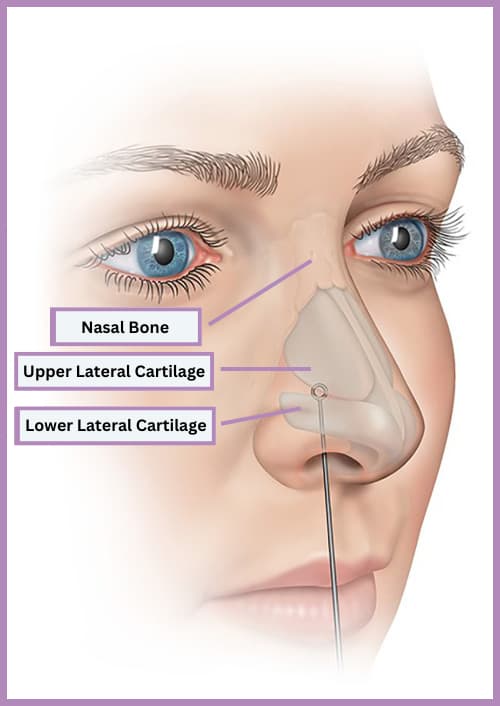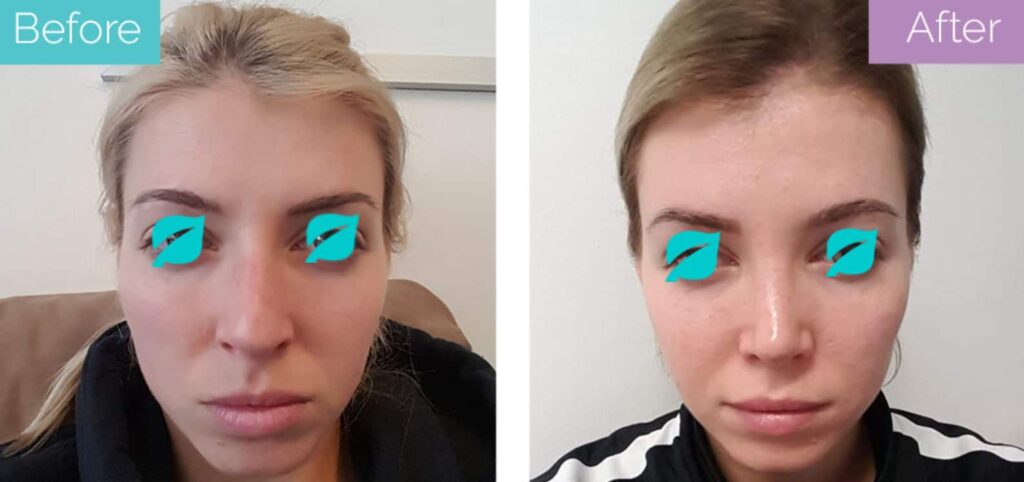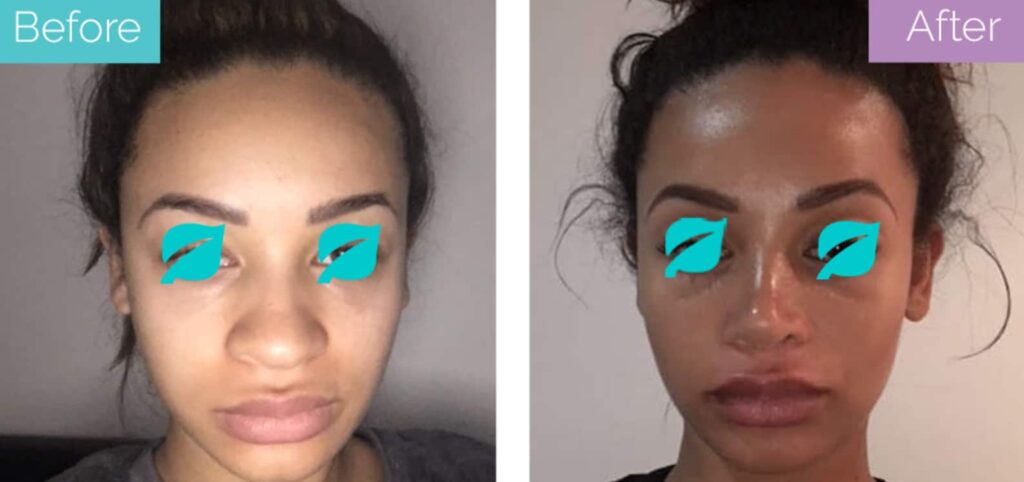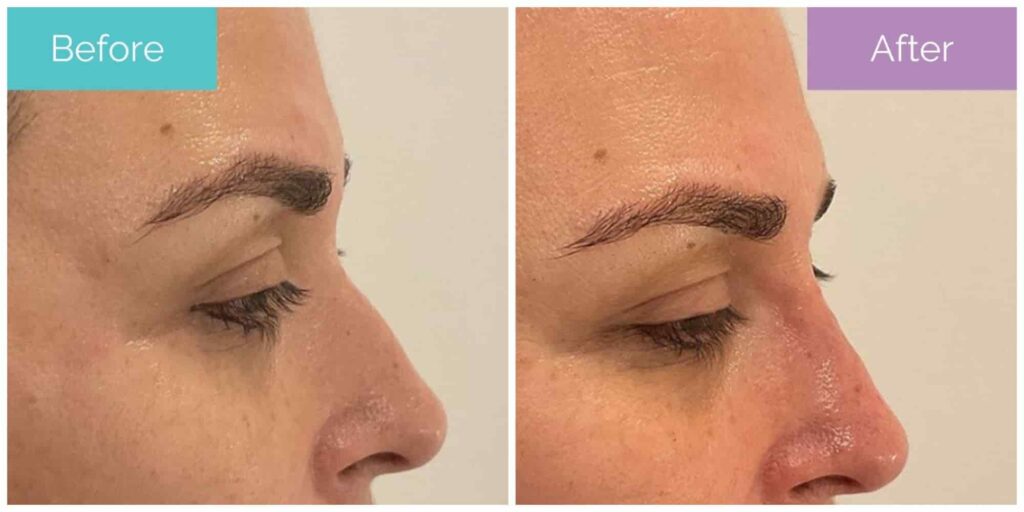Besides the bridge, the nose tip is one of the most common areas where people seek treatment.
Nose tip surgery or tip plasty is a type of surgical rhinoplasty that’s focused on reshaping, resizing, and repositioning the tip of the nose.
This is different from a full rhinoplasty, which addresses both the bones and cartilage of the nose. Here, instead, the focus is on the cartilages only that make up the lower half of the nose – where the tip is.
Understanding this is crucial since you may be better suited for a full rhinoplasty if you have aesthetic issues in other parts of your nose. There are other differences as well which we’ll go over in this guide.
What Is Nose Tip Surgery?
Nasal tip plasty exclusively focuses on changing the cartilage at the tip of the nose.
For this, you need to have an understanding of the basic structure of the nose, which consists of:
- Nasal bones (which make the nose bridge)
- Upper lateral (sideways) cartilage
- Lower lateral cartilage (also known as alar cartilage)

In a nose tip surgery, it’s the lower lateral cartilage that’s the main focus of the surgery. Depending on what the problem is, it may be trimmed, sutured or fitted with a graft to change the appearance of the tip.
For instance, nasal tip rotation is a type of tip plasty in which the angle between the upper lip and the nose tip is changed. The goal is to move the tip upwards.
One of the ways to do this is to trim a part of the lower cartilage, use sutures, and place grafts to rotate the nasal tip.
There are other techniques as well, and they can also include working with the structures around the lower cartilage. Still, the nasal bones remain as they are in tip plasty.
You can, however, choose to combine tip plasty with other types of rhinoplasties, such as septoplasty (if you have breathing issues), dorsal hump reduction, alarplasty (for nostril reduction), etc.
Who’s A Suitable Candidate For Tip Rhinoplasty?
You may be a suitable candidate for nose tip reduction if:
- You have a droopy or downturned nose tip.
- Your nose tip is too upturned.
- You have a poor tip definition.
- You have a boxy or bulbous nose tip.
- You have a nose tip deformity (parenthesis tip deformity, nasal tip bossae, etc.)
- You have a cleft (bifid) nasal tip.
- You have an under-projected tip.
To be able to have this surgery, you should also be in good health. Moreover, your surgeon might also ask you to quit smoking/using tobacco products before the surgery.
How Much Does Nose Tip Surgery Cost?
The average cost of nose tip surgery in the UK is around £4,000.
However, it can vary depending on the experience of your surgeon, the location of the clinic, the type of anaesthesia, and the overall complexity of the procedure. It’s still cheaper than a full rhinoplasty, which can cost £6,000.
Keep in mind that tip plasty is cosmetic surgery, so you won’t be able to get it on the NHS. You’ll have to get it privately, and the consultations, medications and follow-up can also add a few more hundred pounds to your total expense.
To get this surgery more affordably, you can consider medical tourism in Turkey. In Turkey, nose tip surgery by rhinoplasty specialists costs around £1,500. It’s mainly cheaper because of currency exchange rates and low cost of living.
Is Tip Plasty A Major Surgery?
Tip plasty is not exactly a major surgery, but it’s still a complex procedure. It’s generally done under general anaesthesia.
Depending on the problem with your tip, different techniques can be used, such as:
- Suture techniques
- Cutting the upper edges of the lower lateral cartilages (cephalic trim)
- Adding cartilage grafts

The cartilage graft can be taken from the body, such as from the septum, ribs or ear. It is one way to increase the projection of the nose.
Usually, the surgery is done in less than an hour, taking 30 to 45 minutes.
How Long Does Nose Tip Surgery Take To Heal?
The downtime of a nose tip reduction surgery is usually around 1 week. In general, recovery from tip plasty is quicker because nasal bones aren’t involved.
Bruising is less likely to be an issue. Additionally, you might not need any bandage, cast or splint after the surgery.
And although your nose will look different immediately after the surgery, you won’t be able to see the final results until after 1 year. It’s because the swelling can take some time to subside.
Can You Fix A Bulbous Nose Tip Without Surgery?
For a bulbous tip, you might benefit more from a tip plasty than dermal fillers. While a non-surgical nose job is possible with fillers, keep in mind that these injectables add volume to an area.
And if you already have a very wide or large nasal tip, adding volume through fillers might even worsen the bulbosity. A tip plasty, on the other hand, can take care of the root of the problem by readjusting your cartilage.

Here’s it’s also important to understand that a bulbous tip can be a result of the following issues:
- Thick skin draped on the nose
- Wide or large cartilage
- Malpositioned cartilage
Treatment will depend on the underlying cause of the problem.
Unfortunately, in the case of thick skin (which is more common in ethnic noses), your surgeon might consider you unsuitable for the surgery. That’s because this surgery doesn’t change the thickness of the skin.
Can You Change The Tip Of Your Nose Without Surgery?
Liquid rhinoplasty with dermal fillers can help you change your nose tip without surgery. However, there are limitations to what it can do. It can:
- Improve the definition of your tip
- Widen the tip if it’s too narrow
- Help raise dents on the tip
- Elevate the tip

But it can’t dramatically change the overall tip. And this is especially true if you want to reduce something (like a bulbous tip).
Conclusion
Nose tip surgery can be very helpful and effective in changing the appearance of your nasal tip. There are different surgical techniques that can be used for it.
However, it depends on the underlying problem, your aesthetic goals, nose anatomy, etc. Since this surgery doesn’t do anything to the nasal bones, you can also expect to heal more quickly.
In any case, it’s important that for your tip plasty, you find a plastic surgeon who’s board-certified and has the relevant experience and qualifications. They will prepare a treatment plan tailored to your needs.
Reviewed and approved by Prof Dr Fuat Yuksel
FAQ
Is it painful to have nose tip surgery?
Nose tip surgery is not painful since it takes place under anaesthesia. You might experience some pain after the surgery for which your surgeon may prescribe a pain reliever.
How to lift a nose tip without surgery?
Dermal fillers can help lift the tip of your nose without surgery. However, if you have a very droopy nose tip, you might benefit more from a nose tip rotation surgery.
How to make the nose tip smaller without surgery?
Tip plasty might be the most suitable for you if you want to make your nose smaller. Dermal fillers are used for changing nose tips without surgery, but they only add volume. So they won’t make your nose smaller.
Is it safe to have nose tip surgery?
Nose tip surgery is a safe procedure. But it’s important that you choose a qualified and experienced surgeon. Despite that, like all surgeries, it will still carry some risks.




